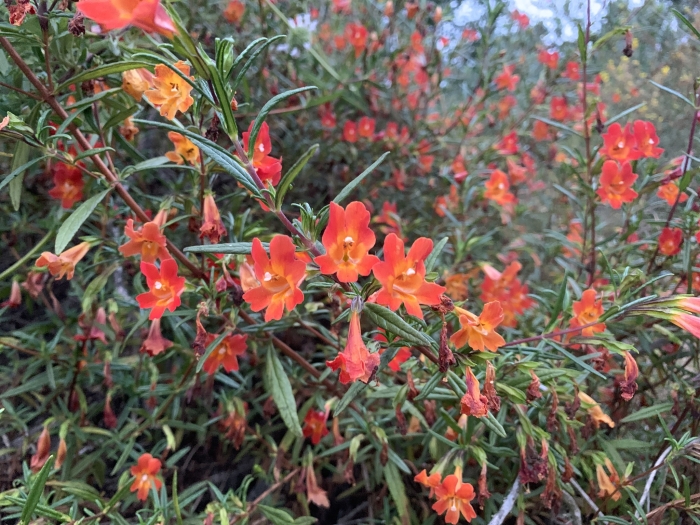Red Bush Monkeyflower
(Diplacus puniceus)
Red Bush Monkeyflower (Diplacus puniceus)
/
/

Eric Alan Isaacson
CC BY 4.0
Image By:
Eric Alan Isaacson
Recorded By:
Copyright:
CC BY 4.0
Copyright Notice:
Photo by: Eric Alan Isaacson | License Type: CC BY 4.0 | License URL: http://creativecommons.org/licenses/by/4.0/ | Rights Holder: Eric Alan Isaacson | Publisher: iNaturalist | Date Created: 2020-06-04T02:51:37Z |































































Estimated Native Range
Summary
Diplacus puniceus, commonly known as Red Bush Monkeyflower, is an evergreen shrub or subshrub native to the chaparral and coastal sage scrub of California and the Baja California region in Northwest Mexico. It typically grows to about 24 inches (60 cm) in height and 36 inches (90 cm) in width. The plant features dark orange to red tubular flowers, each with a broad corolla and a lack of glandular hairs, which are well-adapted for hummingbird pollination. Flowering occurs from March to June, and the blooms are quite showy, attracting both pollinators and gardeners’ attention.
Red Bush Monkeyflower is valued for its vibrant flowers and ability to thrive in drought-prone environments, making it a suitable choice for xeriscaping and water-wise gardens. It is also used in native plant gardens, borders, and as an ornamental accent due to its compact size and striking floral display. This plant is hardy in USDA zones 9a to 11 and prefers well-drained, sandy soils with a pH level between 6 and 8. It is adaptable to various light conditions, performing well in full sun to part shade. While it is drought-tolerant once established, it benefits from occasional watering during prolonged dry spells.CC BY-SA 4.0
Red Bush Monkeyflower is valued for its vibrant flowers and ability to thrive in drought-prone environments, making it a suitable choice for xeriscaping and water-wise gardens. It is also used in native plant gardens, borders, and as an ornamental accent due to its compact size and striking floral display. This plant is hardy in USDA zones 9a to 11 and prefers well-drained, sandy soils with a pH level between 6 and 8. It is adaptable to various light conditions, performing well in full sun to part shade. While it is drought-tolerant once established, it benefits from occasional watering during prolonged dry spells.CC BY-SA 4.0
Plant Description
- Plant Type: Shrub, Subshrub
- Height: 2-3 feet
- Width: 2-3 feet
- Growth Rate: Rapid
- Flower Color: Red
- Flowering Season: Spring, Summer
- Leaf Retention: Evergreen
Growth Requirements
- Sun: Full Sun, Part Shade
- Water: Low, Medium
- Drainage: Fast, Medium
Common Uses
Bank Stabilization, Bee Garden, Bird Garden, Border Plant, Butterfly Garden, Deer Resistant, Drought Tolerant, Erosion Control, Hummingbird Garden, Low Maintenance, Showy Flowers, Street Planting
Natural Habitat
Chaparral and coastal sage scrub in California and the Baja California region in Northwest Mexico
Other Names
Common Names: San Diego Monkey Flower, Mission Diplacus
Scientific Names: , Diplacus puniceus, Mimulus aurantiacus var. puniceus, Mimulus puniceus, Diplacus aurantiacus var. puniceus, Mimulus glutinosus var. puniceus, Diplacus glutinosus var. puniceus, Diplacus longiflorus var. rutilus,
GBIF Accepted Name: Diplacus puniceus Nutt.